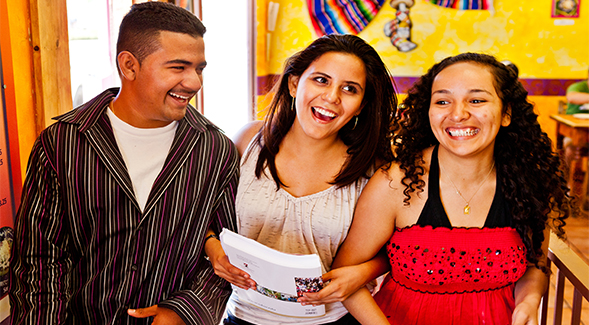Latinx Resource Center Opens at SDSU
The facility, to be located in the SDSU Library, is seen as a show of support.

A new center is opening this month at San Diego State University to provide a welcoming and collaborative environment supportive and inclusive of Latinx community members and allies. A grand opening ceremony for the Latinx Resource Center is set for Thursday, Feb. 20.
The center will be housed in the Chicana and Chicano Collections section of the SDSU Library, adding to the range of identity centers available to students and the campus community. Supporters say it represents an important sign of academic and social support for Latinx students at a time SDSU is seeking to affirm its federally recognized status as a Hispanic-Serving Institution (HSI).
The resource center originated from a proposal submitted by students who were looking to expand the cultural centers on campus, and for a space they felt they could call their own.
“I am really grateful for the university and I am really glad we were able to collaborate on this project to see a student dream come to fruition,” said Angie Espinoza, Associated Students Vice President of External Relations.
“I think this is the first step in making all students feel important and supported on campus.”
Originally funded by the President’s Budget Advisory Committee, the center will receive funding through the Instructionally Related Activities fee, which was approved in fall 2019.
Services will include a culturally-based retention program with peer-mentors trained to assist with emotional, social, and academic engagement of Latinx students. In addition, the center is meant to cultivate a stronger relationship between SDSU and the Latinx community.
Roberto D. Hernandez, an associate professor of Chicana and Chicano studies, says this center is important in making students feel fulfilled and validated while traversing through college.
“A lot of students go through university and graduate but never really felt like a part of the campus,” said Hernandez. “We want students to feel like they have not just the academic support here but also the feeling that there is a shared understanding of their own background and where they come from.”
Augie Garibay, Assistant Chief Diversity Officer and director of Identity Centers said the university’s designation as a Hispanic-Serving Institution, which it has had for nearly eight years, and its proximity to the U.S.-Mexico border are important.
“The HSI designation is only part of the equation,” said Garibay. “The responsibility of SDSU extends beyond attracting, admitting and enrolling Latinx students. Retaining Latinx students involves a systematic approach to identifying the unique barriers which contribute to disparities in graduation and overall success of Latinx students and developing policies, structures, curricula, and practices using an equity minded perspective.”
Hernandez said the access to funding and research opportunities that come with an HSI designation obligate the university to accept “the responsibility to support all students including Latinx ones. We need to determine how we will truly serve Hispanic students and the broader surrounding Hispanic communities.”
SDSU Chief Diversity Officer J. Luke Wood noted that the center speaks to three of the five key priorities proposed for the university’s strategic plan: Students at Our Core, Equity and Inclusion in Everything We Do, and Premier Hispanic-Serving Research University.
“We say ‘Students at Our Core,’ which means we have to serve and support them properly and appropriately,” said Wood. “With ‘Equity and Inclusion in Everything We Do,’ we must improve support for those who are facing disproportionate challenges. This center is going to create new partnerships between students, faculty, staff and the community, which can also lead to expanded research on the Latinx population.”
Additionally, the Department of Chicana and Chicano Studies is celebrating 50 years at SDSU in 2019-20. Garibay said this is a time to acknowledge SDSU’s history with the Latinx community and bolster it.
“As we celebrate the 50th anniversary of Chicana and Chicano Studies at SDSU, the center is a way to honor their many years of advocacy. Latinx students will benefit from the affirming academic, social, cultural-specific support that the LRC will provide, and in turn, the campus community will also benefit.”
Hernandez said it is important to acknowledge this university’s role in the surrounding communities and the relationship it has with people across the county. He wants that to be more visible and feels this center is a great start.
“When a student is looking for universities and when they see we have this HSI badge we want them to recognize that there is actually this broader community and sense of support,” Hernandez said. “Whether they pre-plan for that or not, when looking at schools we want them to know that here they will be taken care of and here they will have the support not just to graduate but to thrive.”
“I think it will be reassuring for both the parents and the students for which leaving their homes and communities may be scary,” Espinoza said.“This center will tell them that they can have a place not only in their own home with their family but also on campus.”



